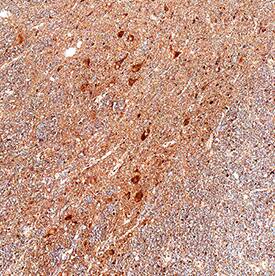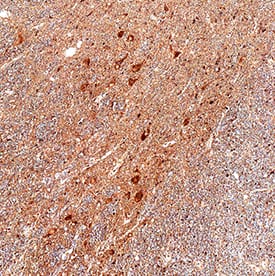Human Spinesin Antibody
R&D Systems, part of Bio-Techne | Catalog # AF2495


Key Product Details
Species Reactivity
Applications
Label
Antibody Source
Product Specifications
Immunogen
Tyr27-Leu413
Accession # Q0P514
Specificity
Clonality
Host
Isotype
Scientific Data Images for Human Spinesin Antibody
Spinesin in Human brain (spinal cord).
Spinesin was detected in immersion fixed paraffin-embedded sections of Human brain (spinal cord) using Goat Anti-Human Spinesin Antigen Affinity-purified Polyclonal Antibody (Catalog # AF2495) at 10 µg/mL for 1 hour at room temperature followed by incubation with the Anti-Goat IgG VisUCyte™ HRP Polymer Antibody (VC004). Tissue was stained using DAB (brown) and counterstained with hematoxylin (blue). Specific staining was localized to motoneurons in ventral horn in the spinal cord.Spinesin in Human brain.
Spinesin was detected in immersion fixed paraffin-embedded sections of human brain using Goat Anti-Human Spinesin Antigen Affinity-purified Polyclonal Antibody (Catalog # AF2495) at 1.5 µg/mL overnight at 4 °C. Tissue was stained using the Anti-Goat IgG VisUCyte™ HRP Polymer Antibody (red; Catalog # VC004) and counterstained with hematoxylin (blue). Specific staining was localized to neurons. View our protocol for Fluorescent ICC Staining of Non-adherent Cells.Applications for Human Spinesin Antibody
Immunohistochemistry
Sample: Immersion fixed paraffin-embedded sections of human dorsal root ganglia and human brain (spinal cord).
Immunoprecipitation
Sample: Conditioned cell culture medium spiked with Recombinant Human Spinesin (Catalog # 2495-SE), see our available Western blot detection antibodies
Western Blot
Sample: Recombinant Human Spinesin (Catalog # 2495‑SE)
Formulation, Preparation, and Storage
Purification
Reconstitution
Formulation
Shipping
Stability & Storage
- 12 months from date of receipt, -20 to -70 °C as supplied.
- 1 month, 2 to 8 °C under sterile conditions after reconstitution.
- 6 months, -20 to -70 °C under sterile conditions after reconstitution.
Background: Spinesin
Spinesin, encoded by the TMPRSS5 gene, is a member of type II transmembrane serine proteases (TTSPs) (1). Human Spinesin contains the following structural domains: a short N-terminal cytoplasmic tail (amino acid residues 1‑49), a transmembrane domain (residues 50‑70), a stem region and a serine protease domain (residues 71‑457) (2). The domain structure of Spinesin is common to other TTSPs, many of which have additional domains. The stem region of Spinesin contains a scavenger receptor-like domain. The ectodomain of human Spinesin (residues 71‑457) was expressed and purified as a single chain pro-enzyme. The deduced amino acid sequence contains a Leu instead of a Phe residue at position 369; the former is identical to the mouse protein (3, 4). The pro-enzyme can be activated and the resulting enzyme activity can be measured as described in the Activity Assay Protocol.
References
- Hooper, J.D. et al. (2001) J. Biol. Chem. 276:857.
- Yamaguchi, Y. et al. (2002) J. Biol. Chem. 277:6806.
- Carninci, P. et al. (2000) Genome Res. 10:1617.
- Shibata, K. et al. (2000) Genome Res. 10:1757.
Alternate Names
Gene Symbol
UniProt
Additional Spinesin Products
Product Documents for Human Spinesin Antibody
Product Specific Notices for Human Spinesin Antibody
For research use only
